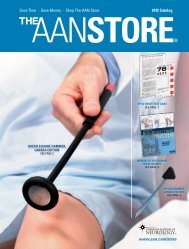MKSAP Neurology Review
MKSAP Neurology Review
MKSAP Neurology Review
Create successful ePaper yourself
Turn your PDF publications into a flip-book with our unique Google optimized e-Paper software.
<strong>MKSAP</strong> <strong>Neurology</strong><br />
<strong>Review</strong><br />
Daniel L. Menkes, M.D.<br />
Professor of <strong>Neurology</strong><br />
University of Connecticut
Approach to neurology<br />
• LOCALIZE the LESION!<br />
– “What means where”<br />
• ELIMINATE EMERGENCIES FIRST!<br />
– VET those emergencies<br />
• Vascular<br />
• Electrical<br />
• Traumatic<br />
• Short differential diagnosis<br />
• Treat the underlying pathology
2 overriding concepts<br />
• Ockham’s Razor for lesions<br />
– Put the lesion in one site if possible OR<br />
– Localize to a particular tissue such as:<br />
• Gray matter<br />
• White matter<br />
• Muscle<br />
• “WIRE CROSSING IS BAD”<br />
– Tracts are PROPERLY laminated<br />
– KNOW where the tracts cross
4 Tracts for lesion localization<br />
• MOTOR system [most important for localization]<br />
– Corticospinal<br />
• Cortical<br />
• Subcortical<br />
– Anterior horn cell starts the peripheral nervous<br />
system<br />
• 2 sensory systems<br />
– DORSAL columns<br />
– Spinothalamic<br />
• Cerebellar [least important for localization]
Motor system first!<br />
[Strength, tone, atrophy, ±reflex]<br />
• CNS lesion?<br />
– Hyper-reflexia (after initial shock)<br />
– Increased tone<br />
– NO ATROPHY (caveat: anterior horn cells)<br />
• Peripheral lesion?<br />
– Decreased reflexes<br />
– Decreased tone<br />
– Atrophy (caveat: demyelinating neuropathies)
Reflex levels-count to 8<br />
REFLEX<br />
Ankle<br />
Knee<br />
Biceps brachii<br />
Brachioradialis<br />
Triceps brachii<br />
ROOT LEVELS<br />
[1 st of pair is predominant]<br />
S1 – S2<br />
L3 – L4<br />
C5 – C6<br />
C5 – C6<br />
C7 – C8
Central nervous system<br />
• Cortical?<br />
– Aphasia?<br />
– Visual field cut?<br />
– Abulia? Apraxia?<br />
– Contralateral neglect?<br />
• Subcortical?<br />
– Hemiparesis<br />
• Brainstem<br />
– Cranial nerve lesion IPSILATERAL<br />
– Hemiparesis CONTRALATERAL<br />
• Spinal cord?<br />
– Both sides of body usually affected<br />
– SENSORY LEVEL LOCALIZES TO SPINAL CORD
Peripheral nervous system<br />
• Anterior horn cell/motor nerve roots<br />
– Invariant weakness with atrophy<br />
– NO SENSORY LOSS<br />
• Peripheral nerve<br />
– Distal weakness WITH sensory loss<br />
• NMJ<br />
– Waxing/Waning weakness<br />
– NO SENSORY LOSS<br />
• Muscle<br />
– Invariant proximal>distal weakness<br />
– NO SENSORY LOSS
SENSORY SYSTEM (2 types)<br />
• LARGE FIBER/DORSAL COLUMN<br />
– Vibration/Position sensation<br />
– Afferent portion of reflex arc<br />
– HIGH CROSS<br />
• SMALL FIBER/SPINOTHALAMIC<br />
– Light touch/Pin/Temperature sensation<br />
– LOW CROSS
Sensory tracts just below the<br />
cervicomedullary junction<br />
• Dorsal columns: [CROSS at C1]<br />
– Sacral fibers are most MEDIAL<br />
– Cervical fibers are most LATERAL<br />
• Spinothalamic: [IMMEDIATE CROSS]<br />
– Sacral fibers most LATERAL<br />
– Cervical fibers most MEDIAL
2 nd Step: Sensory system<br />
• If peripheral: NO DISSOCIATION<br />
– Sensory modalities lost together<br />
– No “splitting”<br />
• If central: DISSOCIATION or LEVEL<br />
– Sensory level = SPINAL CORD<br />
– Dissociation<br />
• Pain and temperature affected on one side<br />
• Vibration and position affected on the other
Cerebellum<br />
• ABOVE cervicomedullary junction<br />
– Usually contralateral to affected side<br />
• BELOW cervicomedullary junction<br />
– Tracts cross twice<br />
– Lesion is ipsilateral to affected side
Major <strong>Neurology</strong> Topics<br />
• Headaches/Brain Tumors<br />
• Delirium/Dementia/Stupor and Coma<br />
• Dizziness/Vertigo/Syncope/Hearing Loss<br />
• Movement disorders<br />
• MS/Spinal cord diseases<br />
• Neuromuscular disease<br />
• Epilepsy<br />
• Stroke
Headaches<br />
• RED FLAGS:<br />
– “Worst headache of life”<br />
– Headache with ANY neurological deficits<br />
– Headache with papilledema<br />
– Headache with fever<br />
– Headache with jaw claudication<br />
• ALL other headaches are usually migraine<br />
– Cluster headaches are extremely rare<br />
– Tension headaches are rarer still
Headaches<br />
• Any “RED FLAG” headache requires:<br />
– Head CT WITHOUT contrast (exclude bleed)<br />
– LP if CT is negative<br />
– ESR if temporal arteritis is suspected<br />
• Non red-flag headaches<br />
– Migraine<br />
– Cluster<br />
– Chronic parxoysmal hemicrania
Migraine headaches<br />
• Unilateral pulsatile HA with photophonophobia<br />
• Pathophysiology-Low pontine serotonin<br />
• Females > Males<br />
• Prophylaxis<br />
– Tricyclic antidepressants<br />
– Beta-blockers<br />
– Anticonvulsants (Depakote, Topamax)<br />
• Abortive<br />
• Triptans<br />
• Sedatives<br />
• Ergotamines
Cluster headaches<br />
• Similar pathophysiology<br />
• Males > females<br />
• Other differences<br />
– Wakes people from sleep in early AM<br />
– Relieved by 10-12 liters of oxygen by mask<br />
– Extreme agitation (migraineurs are reclusive)<br />
– Rhinorrhea and lacrimation
Brain Tumors<br />
• Infiltrators<br />
– Primary CNS neoplasms<br />
– Neural crest derived tumors [melanoma]<br />
• Displacers<br />
– Originate elsewhere<br />
– Supporting elements<br />
• Meningioma<br />
• Ependymoma
Tumor Comparison<br />
Infiltrators<br />
Displacers<br />
Size at<br />
detection<br />
Usual<br />
presentation<br />
Large<br />
Seizures<br />
Minimal deficits<br />
Small<br />
Seizures/HA<br />
Obvious deficit<br />
Location Diffuse Gray-White<br />
junction
Delirium, Dementia, Stupor, Coma<br />
• RED FLAGS:<br />
– Acute onset<br />
– Focal neurological deficits<br />
– Metabolic derangements<br />
• DISEASES you should NEVER MISS:<br />
– Wernicke’s (always give Thiamine)<br />
– B12 or Folate deficiency<br />
– Thyroid disease induced encephalopathy
Delirium, Dementia, Stupor, Coma<br />
Sensorium Interaction with<br />
environment<br />
Delirium Agitated Hostile but<br />
purposeful<br />
Dementia Clear Normal on the<br />
surface<br />
Stupor Clouded Minimal but<br />
purposeful<br />
Coma Obtunded Reflex actions<br />
only
Approach-<br />
Focal neurological deficit?<br />
• Yes: The brain is likely at fault<br />
– Head CT WITHOUT CONTRAST-STAT<br />
– LP if head CT is negative<br />
– EEG if LP is negative<br />
• No: The brain is secondarily affected<br />
– This is a TOXIC-METABOLIC process<br />
– Medication/drug abuse history<br />
– CBC, CMP, TSH, B12, Folate<br />
– RPR, HIV with high index of suspicion
Dementia<br />
• Do not diagnose until you have excluded:<br />
– Pseudodementia (e.g. depression)<br />
– Treatable dementias (B12, Folate, TSH)<br />
• Otherwise, it is probably Alzheimer’s<br />
– Procholinergics slow the rate of decline<br />
– They do NOT reverse the disease process
Delirium<br />
• 99.9% is toxic-metabolic in origin<br />
• Exception: Non-dominant hemisphere<br />
lesions<br />
– Acute stroke<br />
– Herpes simplex encephalitis<br />
• Treatments<br />
– Find the underlying cause and address it<br />
– Tincture of time
Stupor and Coma<br />
• FOCAL DEFICIT = Brain is at fault<br />
• LOCALIZE the lesion<br />
– Examine ALL cranial nerve reflexes:<br />
• Pupillary<br />
• Blink<br />
• Oculocephalic [NOT Doll’s eyes]<br />
• Pharyngeal [NOT gag]<br />
– Posturing?<br />
• Decorticate or arm flexion = above red nucleus<br />
• Decerebrate or arm extension = below red nucleus
Dizziness, Vertigo, Hearing Loss<br />
• Define vertigo<br />
– Illusion of motion<br />
– “Spinning” is not necessary<br />
• Occurs from mismatch of sensory inputs<br />
– Vision<br />
– Posterior columns<br />
– Vestibular system<br />
• MUST differentiate “central “ from<br />
“peripheral”
Central versus peripheral<br />
Central<br />
Peripheral<br />
Long tract signs Presence<br />
confirms central<br />
NEVER<br />
Hearing loss<br />
EXTREMELY<br />
RARE<br />
Virtually<br />
diagnostic<br />
Fatigues No Yes
Common causes of vertigo<br />
• Benign Positional<br />
– Provoked in 1 position ONLY<br />
– Fatigues with each provoking maneuver<br />
• Meniere’s disease is TRIAD of<br />
– Hearing loss [Localizes to periphery]<br />
– Tinnitus<br />
– Vertigo<br />
• Stroke<br />
– Long tract signs<br />
– Cerebellar deficits
Movement disorders<br />
• BALANCE of Ach and DA<br />
– Increased Ach = Decreased DA<br />
– Increased DA = Decreased Ach<br />
• Excess DA leads to:<br />
– Psychosis<br />
– Chorea<br />
• Reduced DA leads to<br />
– Parkinsonism<br />
– Dystonia/Rigidity
Movement disorders<br />
• Parkinson’s Disease [Idiopathic]<br />
– Too little DA in Substantia Nigra<br />
– FOUR cardinal features<br />
• Tremor<br />
• Rigidity<br />
• Bradykinesia<br />
• Postural instability<br />
– Should respond to DA agonists<br />
• Parkinson’s Plus syndromes do NOT respond to<br />
DA therapy
Tremors<br />
• Essential<br />
– Action tremor<br />
– Disappears at rest<br />
• Parkinson’s tremor<br />
– Tremor at REST<br />
– Disappears wit movement<br />
• Cerebellar Tremor [RARE]<br />
– Worsens as the target is approached<br />
– Clinically obvious
Movement disorder therapy<br />
• “Move too much…give them sedatives”<br />
– Beta-blockers<br />
– Barbiturates<br />
– Benzodiazepines<br />
• “Move too little…try some Sinemet”<br />
– Use DA agonists below age 60<br />
– Start Sinemet at age 60 or greater
Some exceptions<br />
• Acute dystonic reaction from DA blocker<br />
– Block Ach to restore balance<br />
– Use diphenhydramine IV<br />
• Parkinson’s tremor does NOT respond to<br />
DA therapy<br />
– Non-anticholinergic sedatives required<br />
• Focal dystonia responds best to Botulinum<br />
toxin injectins
Multiple Sclerosis<br />
• A WHITE MATTER CNS disease<br />
• Two distinct clinical episodes separated in<br />
SPACE and TIME<br />
– Space: Must affect DIFFERENT white matter<br />
locations<br />
– Attacks must be more than 30 days apart<br />
• MRI criteria can be used instead of an<br />
actual SECOND clinical attack
1 lesion ≠ Multiple Sclerosis<br />
• Diagnosis based on location<br />
– Optic tract = Optic Neuritis<br />
– Spinal cord = Transverse myelitis<br />
– Cerebellum = Acute cerebellitis<br />
• Risk of MS increased after first attack<br />
• IV steroids hasten recovery but have NO<br />
EFFECT on probability of second attack<br />
• IV steroids are superior to oral steroids<br />
which are = placebo
MS therapy<br />
• Acute attack- IV methylprednisolone<br />
– Given as 500 mg IV bid for 3-5 days<br />
• Reduce relapse frequency/progression<br />
– Interferons<br />
– Copaxone<br />
• When above agents fail:<br />
– Cyclophosphamide<br />
– Mitoxantrone
Spinal cord disorders<br />
• ALWAYS eliminate cord compression:<br />
– Plain X-rays to exclude bony pathology<br />
– MRI<br />
• CSF exam if previous studies are normal:<br />
– Transverse myelitis<br />
– Meningomyelitides<br />
• Other odd causes<br />
– Spinal cord strokes<br />
– B12 deficiency
Neuromuscular<br />
• LOCALIZE the lesion<br />
– Motor, Sensory or both?<br />
– Trunk, shoulder or hip girdle involved?<br />
– Face involved?<br />
• If motor affected:<br />
– Constant or variable weakness?<br />
– Atrophy?<br />
– Tone increased or decreased?
Nerve structure<br />
• Myelin sheath<br />
– For rapid conduction of impulses<br />
– Vibration and position sense<br />
– Motor function<br />
• Vasa nervorem<br />
– Blood vessels end on nerve surface<br />
– Loss of perfusion affects small fibers in nerve center<br />
• Axons<br />
– Most metabolically active<br />
– Atrophy when the motor axons are injured
Neuropathy vs. myopathy vs. NMJ<br />
• Neuropathy vs. myopathies<br />
– Most neuropathies cause distal before<br />
proximal dysfunction<br />
– Muscle diseases affect proximal before distal<br />
• NMJ disorders usually involve the CNs<br />
– NO sensory loss<br />
– NO atrophy<br />
– Extraocular muscles affected early
Myelinopathy versus axonopathy<br />
• Reflexes lost early<br />
• Large fiber sensory<br />
loss<br />
• Weakness with<br />
minimal atrophy<br />
• CSF protein may be<br />
increased<br />
• Patterns other than<br />
distal to proximal<br />
• Reflexes retained<br />
until late<br />
• Small > large fiber<br />
sensory loss<br />
• CSF protein normal<br />
• Distal to proximal<br />
dysfunction
Myopathies<br />
• Inflammatory usually have increased CPK<br />
– Polymyositis: Cellular infiltrate<br />
– Dermatomyositis: A vasculitis<br />
• Non-inflammatory have normal to<br />
minimally elevated CPK<br />
• Diagnosis can only be established by<br />
biopsy
Epilepsy<br />
• A disorder of the cortical gray matter<br />
• Definition:<br />
– 2 UNPROVOKED seizures<br />
– A CLINICAL diagnosis<br />
• Provoked seizure examples:<br />
– Syncope<br />
– Sleep deprivation<br />
– Alcohol withdrawal
Epilepsy diagnosis<br />
• Clinical to classify the epilepsy<br />
– Reliable witness<br />
– Tongue laceration<br />
– Prolonged LOC<br />
• EEGs do NOT diagnose epilepsy<br />
– Many patients have normal EEGs<br />
– Spikes on an EEG do NOT prove epilepsy
Evaluation<br />
• Elicit complete history to exclude a provoked<br />
seizure<br />
• CBC, CMP, UDS at a minimum<br />
• Imaging<br />
– Generalized only requires head CT<br />
– Focal onset REQUIRES MRI<br />
• EEG<br />
– Highest positives within 24 hrs<br />
– Anticonvulsants do NOT suppress abnormalities
Treatment<br />
• Treatment of a first unprovoked seizure is<br />
controversial but most will do so if any of<br />
the following are noted:<br />
– Focal onset<br />
– EEG abnormalities noted<br />
– MRI abnormality in cortical gray noted<br />
• All anticonvulsants have the same efficacy<br />
for most seizure types-they differ in side<br />
effects
Treatment exceptions<br />
• Juvenile myoclonic epilepsy<br />
– Valproic acid<br />
– Lamotrigine<br />
• Absence seizures<br />
– Valproic acid<br />
– Ethosuximide


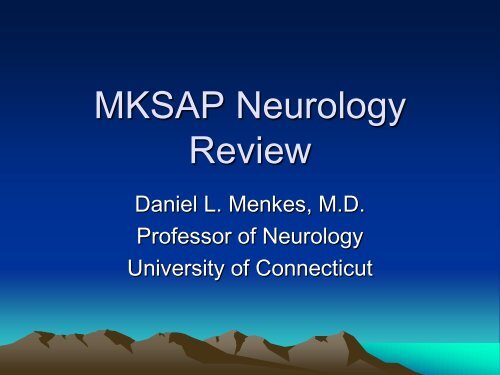
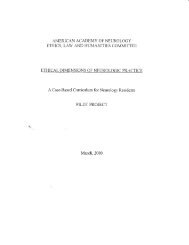

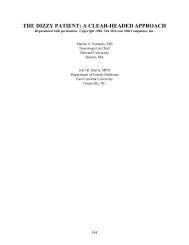

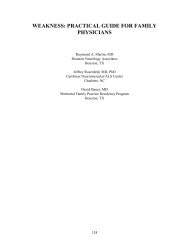
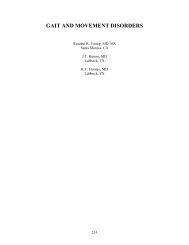
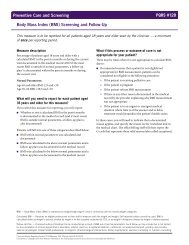
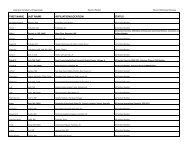
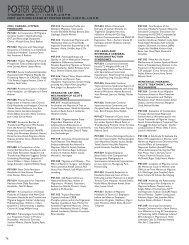
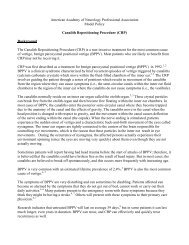
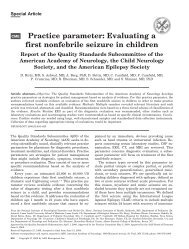

![[Click here and type date] - American Academy of Neurology](https://img.yumpu.com/8582972/1/190x245/click-here-and-type-date-american-academy-of-neurology.jpg?quality=85)
